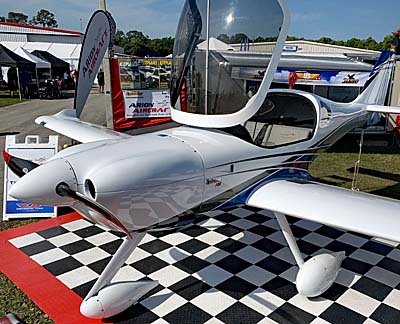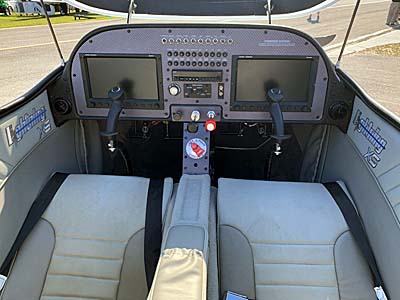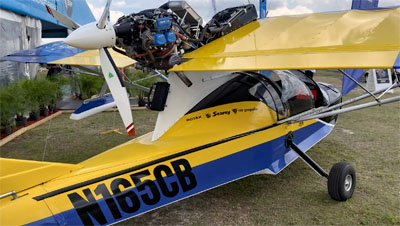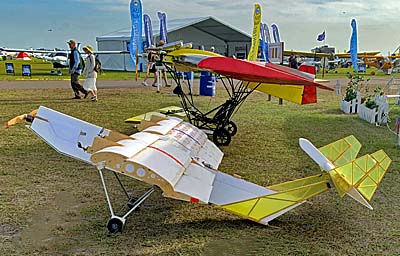You wanna go fast? Of course you do. What pilot doesn’t want to go fast?
Lightning Fast
 Now, ultralight pilots (me, for instance) will go on enthusiastically about the beauty of flying slowly, of drifting leisurely over the landscape at a “human speed” that allows enough time to enjoy the expanse of an aerial view of your surroundings. Open cockpit flying adds to the joy facilitated by low airspeeds.
Now, ultralight pilots (me, for instance) will go on enthusiastically about the beauty of flying slowly, of drifting leisurely over the landscape at a “human speed” that allows enough time to enjoy the expanse of an aerial view of your surroundings. Open cockpit flying adds to the joy facilitated by low airspeeds.
Yet the allure of going fast is great, zipping over the countryside. I get that and when contemplating a cross country trip of any real distance, fast cannot be too fast. In addition to a higher TAS, we all yearn for a tailwind that will raise our speed by another 20 mph.
Arion Aircraft boss Nick Otterback also feels that desire to fly fast. Along with his since-retired but longtime business partner Pete Krotje, Nick created the dashing, sleek and smooth Lightning, first offered as a kit and a compliant Light-Sport Aircraft.
 Lightning has enjoyed and continues to execute a good run but like many designers, Nick felt the design could handle more speed. He set out to bump the numbers by installing a Titan X340 with 180 horsepower. This triggered other changes such as a new cowl to accommodate the powerplant.
Lightning has enjoyed and continues to execute a good run but like many designers, Nick felt the design could handle more speed. He set out to bump the numbers by installing a Titan X340 with 180 horsepower. This triggered other changes such as a new cowl to accommodate the powerplant.
“Our Lightning XS kit has a redesigned forward fuselage structure that gives the builder the option to choose engines up to 180 horsepower,” said Nick. “Taller landing gear for bigger props, bigger brakes, and 20 gallon fuel tanks are among some of the features of this new kit.”
How fast does Lightning XS go? Testing is not complete yet; it recently took to the air. However, Arion is calculating 165 knots (190 mph) TAS at 8,500 feet density altitude at full gross. Climb is a stunning 2,000 fpm.
Of course Lightning XS is not a Light-Sport Aircraft and will require a Private or better certificate plus a medical.
Stronger Climb–Efficient Cruise–Greater Safety
 Rotax, Searey builder Progressive Aerodyne, and RS Technology continue work to acquire knowledge and data about what’s called Single Lever Control (SLC). They’ve been at it a couple years or more and RS Tech is pleased with initial results.
Rotax, Searey builder Progressive Aerodyne, and RS Technology continue work to acquire knowledge and data about what’s called Single Lever Control (SLC). They’ve been at it a couple years or more and RS Tech is pleased with initial results.
Since I first interviewed Michael Stock about this on video, the team has changed to Rotax’s newest 915iS engine that supplies 135 horsepower. Combined with the adjustable prop, this becomes an enthusiastic performer.
The beauty of the system, in my mind, is that it is so simple. A literal single lever makes the pilot workload no more difficult than a conventional throttle on a fixed pitch prop yet it can deliver increased performance to shorten takeoff runs without sacrificing cruise at altitude. This is a win-win safety argument that FAA recognizes. In our discussions with top executives with the agency they proved surprisingly and pleasantly receptive to considering SLC as they rework the SP/LSA regulation. That’s not a guarantee but the odds seem promising. Nonetheless, that regulation is still years away — how many years is an unanswerable question at this point but the wheels of progress are in motion (see an earlier article on this subject).
In talking about regulation change, lots of folks are still asking about a speculated weight increase. Yes, one is definitely coming but not to a specific number. A formula will develop gross weight, and no, the final version of that formula is not yet established.
Lightning Bug 2 Encore Appearance
In the LSA–Sport Pilot kit aircraft–ultralight space, we had a rising star, an emerging talent, and one of the nicest people I’ve met. His name was Brian Austein. Sadly, this bright young man succumbed to cancer and died since last Sun ‘n Fun …a terrible loss. However, his unique legacy lives on in Paradise City in 2019.

Given his prodigious design ability and inventiveness I found it fun to see some of Brian’s other ideas (photo) that he worked on until he died. He bubbled over with ideas as I interviewed him and he wrote from the hospital of another new project in this same ultra-affordable aircraft space. R.I.P. Brian…


Dan, big fan of yours! I understand that an Interem upgrade in Gross weight will Rise to 1550lbs.in the LSA Class & a increase in Cruise Speed of 130knots and a Ceiling Height of 12,500 feet. All these would be Great. What about part 103 Ultr-light class, will there be noticable change in that Class of Flite also? Just inquiring to Hope for Future.
Hi John: Thanks for the kind words. I’m pleased you enjoy the content. ••• Some responses: No, the weight will not be interim (they are planning permanent changes). No, weight will not rise to 1,550 pounds. No, speed may not top out at 130 knots. And, I’ve heard nothing about a ceiling increase (though that limitation is relative to Sport Pilot certificate holders rather than the LSA airplanes. This article explains more but here’s some short replies: Weight will not be specified but could effectively rise to 3,000 pounds or even morel a (wing loading-type) formula will govern such things. Speed should also rise but no number has been mentioned though a likely cap at 200 horsepower engines has been mentioned. As to Part 103, NO changes have been requested. Our focus is on LSA now. Perhaps more could be done with Part 103 later but LAMA people admit to being hesitant to ask for any change, thinking FAA might increase regulation as a final result. I doubt anyone really wants that as we presently have the most charming regulation in all of FAA’s world. Stay tuned… lots more to come. The next four years are going to be mighty interesting.
Is there any idea of what the formula might look like? I realize that it has not yet been decided but how does power, seats, wing size/loading come together to get a weight?
Hi Andy: Yes, I have seen the formula but I am not showing it as FAA is not finished with this yet and it would cause confusion to put out something that very likely will be at least modestly changed.
Please realize the goal is not to come up with a specific weight, any more than FAA advises Cessna or Cirrus how much their aircraft should weigh. The goal is to be less restrictive.
The formula has to do with wing loading and power loading. It will allow heavier aircraft, possibly exceeding 3,000 pounds. It will allow up to four seats (obviously in newly designed aircraft). Industry has a sweet opportunity with this new rule and the LSA sector is set to expand dramatically. However, that does not mean all aircraft will go to much higher weights (or seat count). Some, like weight shift for example, are perfectly happy at the current weight.
Try not to focus on weight, but capability. …and stay tuned for more.
Excellent article, with fresh updates from the man in the know. Thanks Dan, I don’t know where we’d be without you!
Hi Ted: That’s very kind of you to say. I’m pleased you are enjoying the content here.